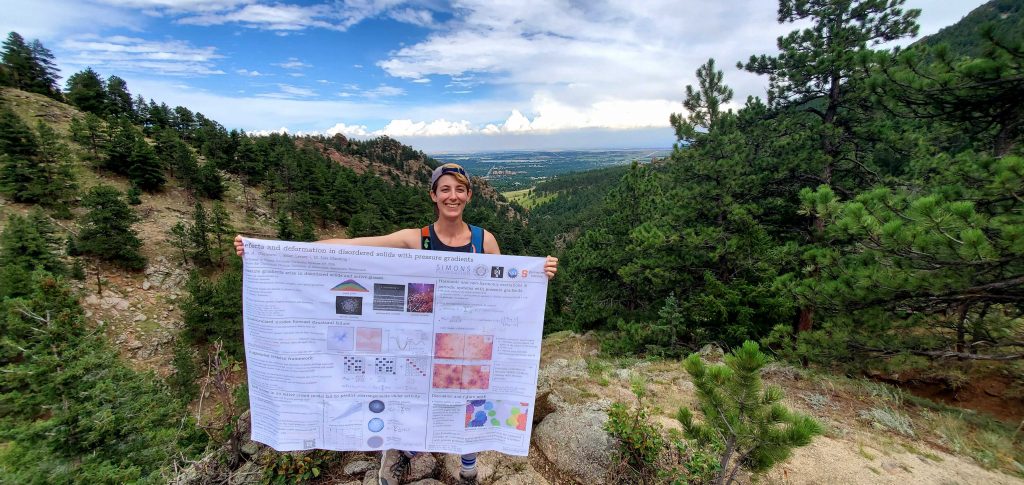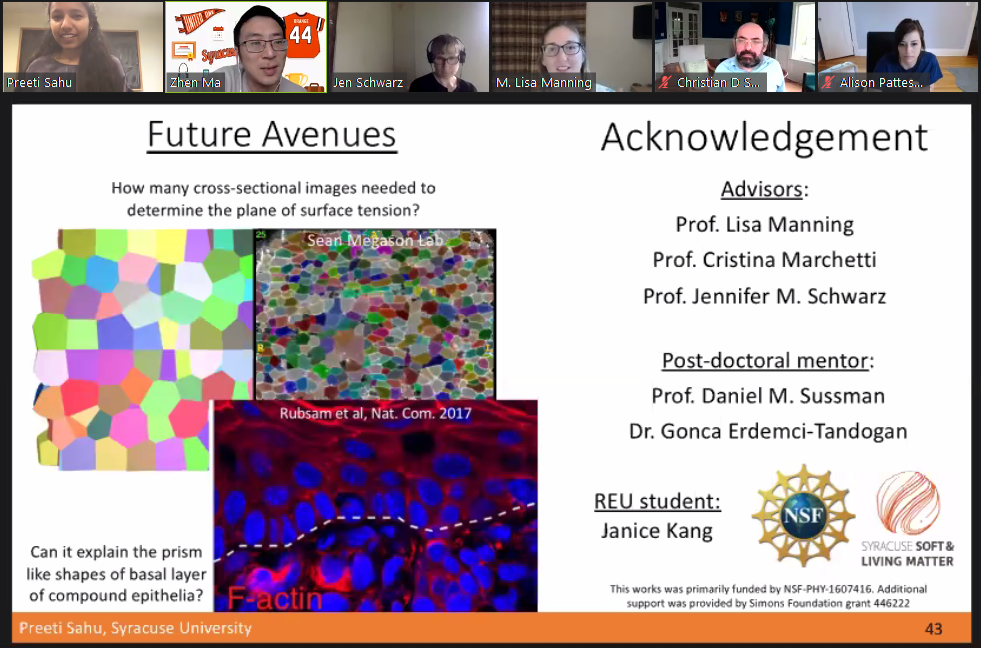Well, the pandemic put quite a damper on us publishing group news on our website. Despite appearances, since the last post we’ve published a lot of exciting work. Congratulations to all of our students, postdocs, and collaborators on making progress in difficult times! Here’s the 8 papers that we’ve published in the last year or so:
Gonca Erdemci-Tandogan and M. L. Manning. Effect of cellular rearrangement time delays on the rheology of vertex models for confluent tissues, PLOS Comp. Bio 17(6): e1009049, https://journals.plos.org/ploscompbiol/article?id=10.1371/journal.pcbi.100904 BioRXiv: https://doi.org/10.1101/2021.02.13.431087 (2021).
Peter K. Morse, Sudeshna Roy, Elisabeth Agoritsas, Ethan Stanifer, Eric I. Corwin, M. Lisa Manning. “A direct link between active matter and sheared granular systems,” accepted to PNAS, https://arxiv.org/abs/2009.07706 (2020).
John Devany, Daniel M. Sussman, Takaki Yamamoto, M. Lisa Manning, Margaret L. Gardel, “Cell division Rate Controls Cell Shape Remodeling in Epithelia,” PNAS https://www.pnas.org/content/118/10/e1917853118, on BioRXiv: https://doi.org/10.1101/804294 (2021).
Steffen Grosser, Jürgen Lippoldt, Linda Oswald, Matthias Merkel, Daniel M. Sussman, Frédéric Renner, Pablo Gottheil, Erik W. Morawetz, Thomas Fuhs, Xiaofan Xie, Steve Pawlizak, Anatol W. Fritsch, Benjamin Wolf, Lars-Christian Horn, Susanne Briest, Bahriye Aktas, M. Lisa Manning, and Josef A. Käs. “Cell and Nucleus Shape as an Indicator of Tissue Fluidity in Carcinoma,” Physical Review X https://doi.org/10.1103/PhysRevX.11.011033 (2021).
David Richard* Geert Kapteijns* Julia A. Giannini, M. Lisa Manning, and Edan Lerner, “A simple and broadly-applicable definition of shear transformation zones,” accepted to Phys. Rev. Lett., https://arxiv.org/abs/2007.08181 (2020).
Diogo E. P. Pinto, Gonca Erdemci-Tandogan, M. Lisa Manning, and Nuno A. M. Araujo. “The cell adaptation time sets a minimum length scale for patterned substrates,” Biophysical Journal 119,11 https://doi.org/10.1016/j.bpj.2020.10.026, https://arxiv.org/abs/2005.01518 (2020).
D. Richard, M. Ozawa, S. Patinet, E. Stanifer, B. Shang, S. Ridout, B. Xu, G. Zhang, P. Morse, J.-L. Barrat, L. Berthier, M.L. Falk, P. Guan, A. Liu, K. Martens, S. Sastry, D. Vandembroucq, E. Lerner, and M.L. Manning. “Predicting plasticity in disordered solids from structural indicators,” Physical Review Materials 4, 113609 https://doi.org/10.1103/PhysRevMaterials.4.113609arXiv:2003.11629 (2020).
Peter Morse, Merlijn van Deen, Sven Wijtmans, Martin Van Hecke, M. L. Manning, “Two classes of events in sheared particulate matter,” Physical Review Research 2 023179, https://link.aps.org/doi/10.1103/PhysRevResearch.2.023179arXiv:1907.10198 (2020).



